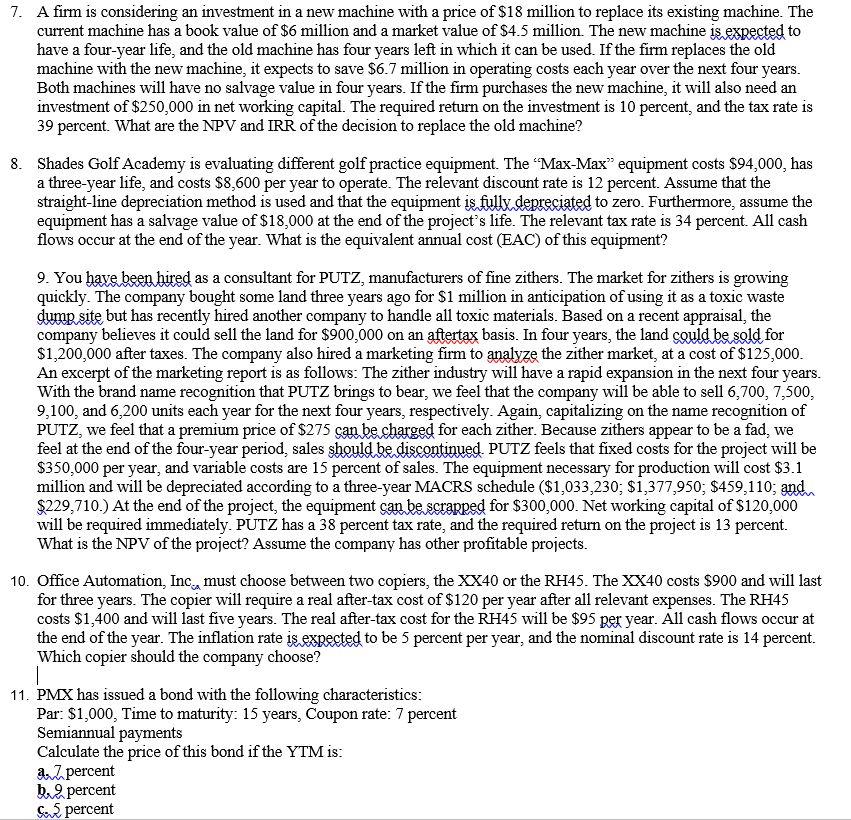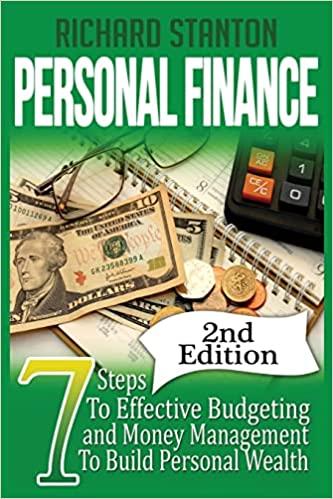Answered step by step
Verified Expert Solution
Question
1 Approved Answer
QUESTIONS 7 TO 17 12. Renaissance Corporation has bonds on the market with 11.5 years to maturity, a YTM of 7.6 percent, and a current

 QUESTIONS 7 TO 17
QUESTIONS 7 TO 17
12. Renaissance Corporation has bonds on the market with 11.5 years to maturity, a YTM of 7.6 percent, and a current price of $1,060. The bonds make semiannual payments. What must the coupon rate be on these bonds? Assume that par value is $1,000. 13. You buy a zero coupon bond at the beginning of the year that has a face value of $1,000, a YTM of 7 percent, and 25 years to maturity. If you hold the bond for the entire year and sell it, how much in interest income will you have to declare on your tax return? 14. Lauriel, Inc., and Harmony Corp. both have 7 percent coupon bonds outstanding, with semiannual interest payments, and both are priced at par value. The Lauriel, Inc., bond has 2 years to maturity, whereas the Harmony Corp. bond has 15 years to maturity. If interest rates suddenly rise by 2 percent, what is the percentage change in the price of these bonds? If interest rates were to suddenly fall by 2 percent instead, what would the percentage change in the price of these bonds be then? 15. You own $100,000 worth of SMS stock. One year from now, you will receive a dividend of $2.25 per share. You will receive a $2.40 dividend two years from now. You will sell the stock for $65 per share three years from now. Dividends are taxed at the rate of 28 percent. Assume there is no capital gains tax. The after-tax required rate of return is 15 percent. How many shares of stock do you own? 16. PMW Mineral Water, Inc ua will pay a quarterly dividend per share of $.80 at the end of each of the next 12 quarters. Thereafter, the dividend will grow at a quarterly rate of 1 percent, forever. The appropriate rate of return on the stock is 10 percent, compounded quarterly. What is the current stock price? 17. The Starbucks Corporation currently has earnings per share of $9.40. The company has no growth and pays out all earnings as dividends. It has a new project that will require an investment of $1.95 per share in one year. The project is only a two-year project, and it will increase earnings in the two years following the investment by $2.75 and $3.05, respectively. Investors require a return of 12 percent on Starbucks stock. a. What is the value per share of the company's stock assuming the firm does not undertake the investment opportunity? b. If the company does undertake the investment, what is the value per share now? c. Again, assume the company undertakes the investment. What will the price per share be four years from today? 7. A firm is considering an investment in a new machine with a price of $18 million to replace its existing machine. The current machine has a book value of $6 million and a market value of $4.5 million. The new machine is expected to have a four-year life, and the old machine has four years left in which it can be used. If the firm replaces the old machine with the new machine, it expects to save $6.7 million in operating costs each year over the next four years. Both machines will have no salvage value in four years. If the firm purchases the new machine, it will also need an investment of $250,000 in net working capital. The required return on the investment is 10 percent, and the tax rate is 39 percent. What are the NPV and IRR of the decision to replace the old machine? 8. Shades Golf Academy is evaluating different golf practice equipment. The "Max-Max" equipment costs $94,000, has a three-year life, and costs $8,600 per year to operate. The relevant discount rate is 12 percent. Assume that the straight-line depreciation method is used and that the equipment is fully depreciated to zero. Furthermore, assume the equipment has a salvage value of $18,000 at the end of the project's life. The relevant tax rate is 34 percent. All cash flows occur at the end of the year. What is the equivalent annual cost (EAC) of this equipment? 9. You have been hired as a consultant for PUTZ, manufacturers of fine zithers. The market for zithers is growing quickly. The company bought some land three years ago for $1 million in anticipation of using it as a toxic waste dump site but has recently hired another company to handle all toxic materials. Based on a recent appraisal, the company believes it could sell the land for $900,000 on an aftertax basis. In four years, the land could be sold for $1,200,000 after taxes. The company also hired a marketing firm to analyze the zither market, at a cost of $125,000. An excerpt of the marketing report is as follows: The zither industry will have a rapid expansion in the next four years. With the brand name recognition that PUTZ brings to bear, we feel that the company will be able to sell 6,700,7,500, 9,100 , and 6,200 units each year for the next four years, respectively. Again, capitalizing on the name recognition of PUTZ, we feel that a premium price of $275 can be charged for each zither. Because zithers appear to be a fad, we feel at the end of the four-year period, sales should be discontinued. PUTZ feels that fixed costs for the project will be $350,000 per year, and variable costs are 15 percent of sales. The equipment necessary for production will cost $3.1 million and will be depreciated according to a three-year MACRS schedule ($1,033,230;$1,377,950; $459,110; and $229,710.) At the end of the project, the equipment can be scrapped for $300,000. Net working capital of $120,000 will be required immediately. PUTZ has a 38 percent tax rate, and the required return on the project is 13 percent. What is the NPV of the project? Assume the company has other profitable projects. for three years. The copier will require a real after-tax cost of $120 per year after all relevant expenses. The RH45 costs $1,400 and will last five years. The real after-tax cost for the RH45 will be $95 per year. All cash flows occur at the end of the year. The inflation rate is expected to be 5 percent per year, and the nominal discount rate is 14 percent. Which copier should the company choose? 11. PMX has issued a bond with the following characteristics: Par: $1,000, Time to maturity: 15 years, Coupon rate: 7 percent Semiannual payments Calculate the price of this bond if the YTM is: a. 7 percent br 2 percent c. 5 percent
Step by Step Solution
There are 3 Steps involved in it
Step: 1

Get Instant Access to Expert-Tailored Solutions
See step-by-step solutions with expert insights and AI powered tools for academic success
Step: 2

Step: 3

Ace Your Homework with AI
Get the answers you need in no time with our AI-driven, step-by-step assistance
Get Started


